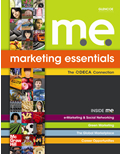Marketing Essentials 2012Chapter 34:
Risk ManagementeMarketing FeaturePhishing and Identity Theft
Phishing is obtaining personal information from individuals via the Internet of by telephone and using it for illegitimate purposes. Phishing often involves an e-mail sent from what appears to be a legitimate company that requests an individual to update his or her account information. The data collected through phishing is often used for identity theft. Identity theft is stealing a person's personal data such as social security number, telephone, address, credit card number, and other information. The Federal Trade Commission's Web site provides consumers and businesses with suggestions and regulations for identity theft protection and protocol. Innovate and Create
Part of risk management involves preventing cyber-thieves from gaining access to customers' records. Businesses are required to implement Identity Theft Prevention Programs. The Federal Trade Commission publishes a guideline called "Red Flags Rule" and provides an online template to help businesses comply. Have students visit the FTC's Web site to review the "Red Flags Rule" template. Have students assume they work for an online business that takes phone orders, such as a gift basket company or online florist. Have students work in groups to complete the Red Flags Rule compliance template for a specific online business that takes phone orders.  | 




